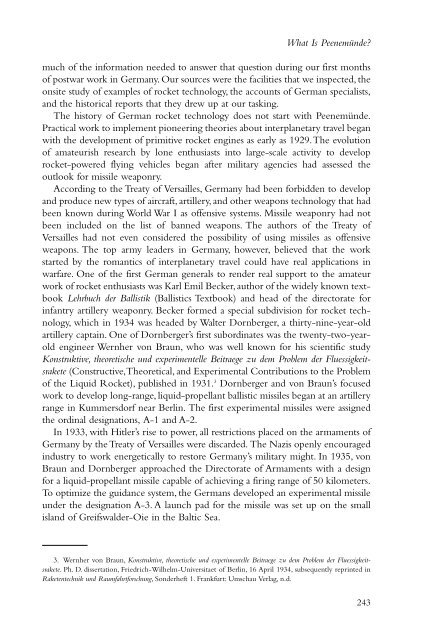to open next chapter. - NASA's History Office
to open next chapter. - NASA's History Office
to open next chapter. - NASA's History Office
Create successful ePaper yourself
Turn your PDF publications into a flip-book with our unique Google optimized e-Paper software.
What Is Peenemünde?<br />
much of the information needed <strong>to</strong> answer that question during our first months<br />
of postwar work in Germany. Our sources were the facilities that we inspected, the<br />
onsite study of examples of rocket technology, the accounts of German specialists,<br />
and the his<strong>to</strong>rical reports that they drew up at our tasking.<br />
The his<strong>to</strong>ry of German rocket technology does not start with Peenemünde.<br />
Practical work <strong>to</strong> implement pioneering theories about interplanetary travel began<br />
with the development of primitive rocket engines as early as 1929.The evolution<br />
of amateurish research by lone enthusiasts in<strong>to</strong> large-scale activity <strong>to</strong> develop<br />
rocket-powered flying vehicles began after military agencies had assessed the<br />
outlook for missile weaponry.<br />
According <strong>to</strong> the Treaty of Versailles, Germany had been forbidden <strong>to</strong> develop<br />
and produce new types of aircraft, artillery, and other weapons technology that had<br />
been known during World War I as offensive systems. Missile weaponry had not<br />
been included on the list of banned weapons. The authors of the Treaty of<br />
Versailles had not even considered the possibility of using missiles as offensive<br />
weapons. The <strong>to</strong>p army leaders in Germany, however, believed that the work<br />
started by the romantics of interplanetary travel could have real applications in<br />
warfare. One of the first German generals <strong>to</strong> render real support <strong>to</strong> the amateur<br />
work of rocket enthusiasts was Karl Emil Becker, author of the widely known textbook<br />
Lehrbuch der Ballistik (Ballistics Textbook) and head of the direc<strong>to</strong>rate for<br />
infantry artillery weaponry. Becker formed a special subdivision for rocket technology,<br />
which in 1934 was headed by Walter Dornberger, a thirty-nine-year-old<br />
artillery captain. One of Dornberger’s first subordinates was the twenty-two-yearold<br />
engineer Wernher von Braun, who was well known for his scientific study<br />
Konstruktive, theoretische und experimentelle Beitraege zu dem Problem der Fluessigkeitsrakete<br />
(Constructive,Theoretical, and Experimental Contributions <strong>to</strong> the Problem<br />
of the Liquid Rocket), published in 1931. 3 Dornberger and von Braun’s focused<br />
work <strong>to</strong> develop long-range, liquid-propellant ballistic missiles began at an artillery<br />
range in Kummersdorf near Berlin. The first experimental missiles were assigned<br />
the ordinal designations, A-1 and A-2.<br />
In 1933, with Hitler’s rise <strong>to</strong> power, all restrictions placed on the armaments of<br />
Germany by the Treaty of Versailles were discarded. The Nazis <strong>open</strong>ly encouraged<br />
industry <strong>to</strong> work energetically <strong>to</strong> res<strong>to</strong>re Germany’s military might. In 1935, von<br />
Braun and Dornberger approached the Direc<strong>to</strong>rate of Armaments with a design<br />
for a liquid-propellant missile capable of achieving a firing range of 50 kilometers.<br />
To optimize the guidance system, the Germans developed an experimental missile<br />
under the designation A-3. A launch pad for the missile was set up on the small<br />
island of Greifswalder-Oie in the Baltic Sea.<br />
3. Wernher von Braun, Konstruktive, theoretische und experimentelle Beitraege zu dem Problem der Fluessigkeitsrakete.<br />
Ph. D. dissertation, Friedrich-Wilhelm-Universitaet of Berlin, 16 April 1934, subsequently reprinted in<br />
Raketentechnik und Raumfahrtforschung, Sonderheft 1. Frankfurt: Umschau Verlag, n.d.<br />
243
















